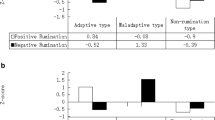Abstract
In an attempt to eliminate similar item content as an alternative explanation for the relation between depression and rumination, a secondary analysis was conducted using the data from S. Nolen-Hoeksema, J. Larson, and C. Grayson (1999). After constructing a measure of rumination unconfounded with depression content, support for a two factor model of rumination was found. These analyses indicate that the 2 components, reflective pondering and brooding, differentially relate to depression in terms of predictive ability and gender difference mediation. The results presented here support the general premise of Nolen-Hoeksema's Response Styles Theory (S. Nolen-Hoeksema 1987) that rumination can contribute to more depressive symptoms and to the gender difference in depression, but suggest important refinements of the theory. Such refinements include the need to differentiate between the reflective pondering component of rumination and the brooding component in rumination research.
Similar content being viewed by others
References
Bagby, R. M., & Parker, J. D. A. (2001). Relation of rumination and distraction with neuroticism and extraversion in a sample of patients with major depression. Cognitive Therapy and Research, 25(1), 91–102.
Baron, R. M., & Kenny, D. A. (1986). The moderator–mediator variable distinction in social psychological research: Conceptual, strategic, and statistical considerations. Journal of Personality and Social Psychology, 51(6), 1173–1182.
Beck, A. T., Ward, C. H., Mendelsohn, M., Mock, J., & Erbaugh, J. (1961). An inventory for measuring depression. Archives of General Psychiatry, 4, 561–571.
Carver, C. S., & Scheier, M. F. (1981). Attention and self-regulation: A control-theory approach to human behavior. New York: Springer.
Conway, M., Csank, P. A. R., Holm, S. L., & Blake, C. K. (2000). On assessing individual differences in rumination on sadness. Journal of Personality Assessment, 75(3), 404–425.
Cox, B. J., Enns, M. W., & Taylor, S. (2001). The effect of rumination as a mediator of elevated anxiety sensitivity in major depression. Cognitive Therapy and Research, 25(5), 525–534.
Darlington, R. (1990). Regression and Linear Models. New York: McGraw-Hill.
Gonzalez, R., & Griffin, D. (2001). Testing parameters in structural equation modeling: Every “one” matters. Psychological Methods, 6, 258–269.
Goodman, L. A. (1960). On the exact variance of products. Journal of the American Statistical Association, 55(292), 708–713.
Just, N., & Alloy, L. B. (1997). The response styles theory of depression: Tests and an extension of the theory. Journal of Abnormal Psychology, 106(2), 221–229.
Kessler, R. C., McGonagle, K. A., Swartz, M., Blazer, D. G., & Nelson, C. B. (1993). Sex and depression in the national comorbidity survey I: Lifetime prevalence, chronicity and recurrence. Journal of Affective Disorders, 29, 85–96.
Kuehner, C., & Weber, I. (1999). Responses to depression in unipolar depressed patients: An investigation of Nolen-Hoeksema's response styles theory. Psychological Medicine, 29, 1323–1333.
Lyubomirsky, S., & Nolen-Hoeksema, S. (1993). Self-perpetuating properties of dysphoric rumination. Journal of Personality and Social Psychology, 65(2), 339–349.
Lyubomirsky, S., & Ross, L. (1997). Hedonic consequences of social comparison: A contrast of happy and unhappy people. Journal of Personality and Social Psychology, 73, 1141–1157.
Lyubomirsky, S., Tucker, K. L., & Kasri, F. (2001). Responses to hedonically conflicting social comparisons: Comparing happy and unhappy people. European Journal of Social Psychology, 31, 1–25.
Martin, L. L., & Tesser, A. (1996). Some ruminative thoughts. In R. S. Wyer Jr. (Ed.), Advances in social cognition (pp. 1–47). Hillsdale, NJ: Erlbaum.
Morrow, J., & Nolen-Hoeksema, S. (1990). Effects of responses to depression on the remediation of depressive affect. Journal of Personality and Social Psychology, 58(3), 519–527.
Nolan, S. A., Roberts, J. E., & Gotlib, I. H. (1998). Neuroticism and ruminative response style as predictors of change in depressive symptomatology. Cognitive Therapy and Research, 22(5), 445–455.
Nolen-Hoeksema, S. (1987). Sex differences in unipolar depression: Evidence and theory. Psychological Bulletin, 101(2), 259–282.
Nolen-Hoeksema, S. (1991). Responses to depression and their effects on the duration of depressive episodes. Journal of Abnormal Psychology, 100(4), 569–582.
Nolen-Hoeksema, S. (2000). The role of rumination in depressive disorders and mixed anxiety/depressive Symptoms. Journal of Abnormal Psychology, 109(3), 504–511.
Nolen-Hoeksema, S., & Jackson, B. (2001). Mediators of the gender difference in rumination. Psychology of Women Quarterly, 25, 37–47.
Nolen-Hoeksema, S., Larson, J., & Grayson, C. (1999). Explaining the gender difference in depressive symptoms. Journal of Personality and Social Psychology, 77(5), 1061–1072.
Nolen-Hoeksema, S., & Morrow, J. (1991). A prospective study of depression and posttraumatic stress symptoms after a natural disaster: The 1989 loma prieta earthquake. Journal of Personality and Social Psychology, 61(1), 115–121.
Nolen-Hoeksema, S., Morrow, J., & Fredrickson, B. L. (1993). Response styles and the duration of episodes of depressed mood. Journal of Abnormal Psychology, 102(1), 20–28.
Nolen-Hoeksema, S., Parker, L. E., & Larson, J. (1994). Ruminative coping with depressed mood following loss. Journal of Personality and Social Psychology, 67(1), 92–104.
Pysczcynski, T., & Greenberg, J. (1987). Self-regulatory perseveration and the depressive self-focusing style: A self-awareness theory of reactive depression. Psychological Bulletin, 201, 122–138.
Roberts, J. E., Gilboa, E., & Gotlib, I. H. (1998). Ruminative response style and vulnerability to episodes of dysphoria: Gender, neuroticism, and episode duration. Cognitive Therapy and Research, 22(4), 1998, 401–423.
Segerstrom, S. C., Tsao, J. C. I., Alden, L. E., & Craske, M. G. (2000). Worry and rumination: Repetitive thought as a concomitant and predictor of negative mood. Cognitive Therapy and Research, 24, 671–688.
Siegle, G. J., Steinhauer, S. R., Carter, C. S., & Thase, M. E. (2003). Do the seconds turn into hours? Relationships between sustained pupil dilation in response to emotional information and self-reported information. Cognitive Therapy and Research, 27(3), 247–259.
Steiger, J. H. (1980). Tests for comparing elements of a correlation matrix. Psychological Bulletin, 87, 245–251.
Trapnell, P. D., & Campbell, J. D. (1999). Private self-consciousness and the five-factor model of personality: Distinguishing rumination from reflection. Journal of Personality and Social Psychology, 76, 284–304.
Wood, J. V., Saltzberg, J. A., Neale, J. M., Stone, A. A., & Rachmiel, T. A. (1990). Self-focused attention, coping responses, and distressed mood in everyday life. Journal of Personality and Social Psychology, 58(6), 1027–1036.
Woolf, H. B. (Ed.). (1981). Webster's new collegiate dictionary. Springfield, MA: G. & C. Merriam Company.
Wyer, R. S., Jr. (Ed.). (1996). Advances in social cognition. Hillsdale, NJ: Erlb
Author information
Authors and Affiliations
Corresponding author
Rights and permissions
About this article
Cite this article
Treynor, W., Gonzalez, R. & Nolen-Hoeksema, S. Rumination Reconsidered: A Psychometric Analysis. Cognitive Therapy and Research 27, 247–259 (2003). https://doi.org/10.1023/A:1023910315561
Issue Date:
DOI: https://doi.org/10.1023/A:1023910315561




